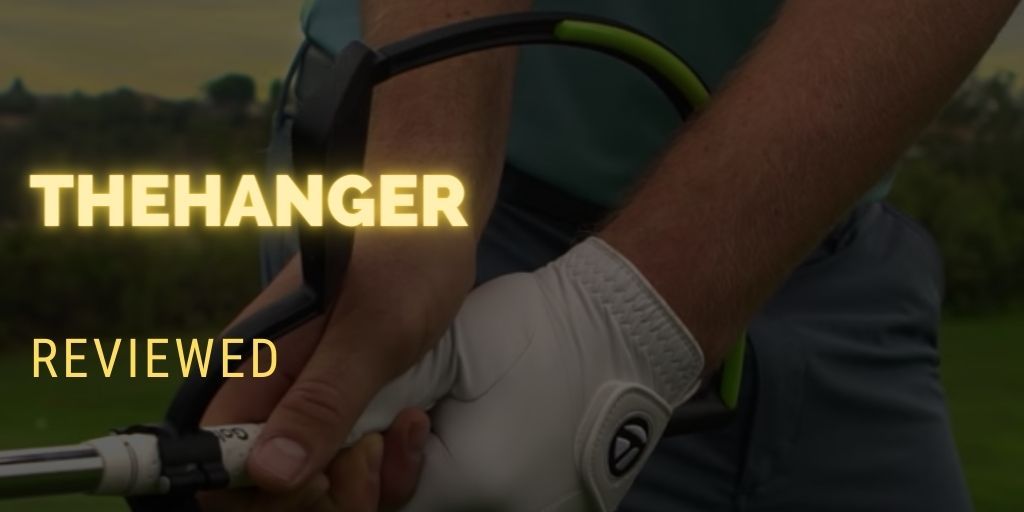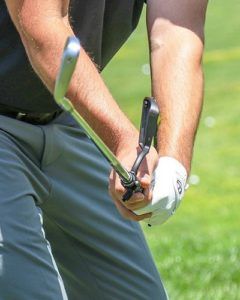
A successful swing will look different for every golfer, and there's probably no "ideal" swing that will work for everyone. That said, there are certain positions and movements that almost all good golf swings have. In my mind, golf training aids work best when they help golfers feel and practice one of those critical areas. theHANGER from Watson Golf definitely seems to be targeting one of those swing essentials, and in this review, we'll see if it is successful.

How's theHANGER Supposed to Help Your Game?
All else being equal, it's safe to say that a square clubface is more likely to produce better shots than not. A square clubface is controlled largely by the wrists and forearms as they twist the club open and closed. The theHANGER is designed to promote awareness and train golfers to maintain a square clubface through impact. Here's a video from Watson Golf introducing the basics of the training aid.
https://youtu.be/M4zuf1-yYNE
The concept here is not necessarily new as the theHANGER even takes its name from a drill long used by many instructors to promote this type of awareness using a cheap clothes hanger, as can be seen here from Me And My Golf.
https://youtu.be/t-Fy8JOvqjY
With either the idea being the same, maintaining contact between the training aid and the forearm through the swing will promote a flat lead wrist and have a visual reference point for the clubface angle. Ideally, with consistent practice, using it should produce a more consistent, repeatable swing with correct hand and wrist positions.
My Experience with theHANGER

Setup
While it's always recommended to explore resources and watch the instructional videos before using any training aid, out of the box, it was pretty easy to understand how to set up and use the theHANGER. I always find that to be something important with training aids as I think it's what most golfers do. To attach the theHANGER to my club, I just had to line up the clubface visual aid with my own clubface and then latch the device down on the top and bottom of the grip, screwing down wingnuts to make it secure.
As an Arccos user, I was a little concerned that the sensors might not allow the theHANGER to attach correctly. Initially, I removed them, but later testing showed that while theHANGER seems a little less secure when used with the sensors attached, it didn't impact usability. Also, I use standard-sized grips, but given the latches' size, I'm not sure if the theHANGER would work well with oversized grips like JumboMax.
Use
Like other training aids, theHANGER's mantra is to start slow and work your way into full swings. Starting in slow motion without a ball, focusing on getting theHANGER into contact with my lead arm encouraged a one-piece takeaway and helped not break down my wrists at the top of the backswing. Maintaining contact through the downswing seemed to help keep my hands in front of the clubhead and keep from flipping my wrists through impact. From these rehearsal practice swings, I could then add in more speed to slowly approach a real swing and hit balls while using the aid.
While the bulk practice with theHANGER was done with a 6 iron out of personal preference (it always tends to be my club of choice for training aids), theHANGER works with pretty much every club in the bag. For example, for anyone who struggles with flipping the club in their chipping technique, popping theHANGER on a wedge will help.
While this type of flexibility is positive, I will note that I did find the process of removing and reattaching theHANGER to my clubs to be somewhat cumbersome in my regular practice routine. Ideally, when using a training aid, I like to take a few swings with the training aid attached, and then a few more with it removed, going back and forth to try and maintain the feeling. With a plain clothes hanger, this is easy as you can toss it to the side.
While having theHANGER attached to the club keeps it more stable during the swing, it was hard to get into a rhythm when I needed to screw/unscrew wingnuts and always double-check the alignment. In the end, I wound up just using my six iron with theHANGER attached and then a seven iron without it during practice. I know this is a small issue, but it is something I noticed. This kind of strategy won't work for practicing the driver, for example, unless you bring two of them with you.
Outside of that relatively small issue, I found theHANGER to be uncomplicated to use. The device itself isn't all that bulky and can probably fit in the large side pocket of most regular golf bags, and it's a training aid that won't cause a lot of stares on a crowded driving range. The big question is; does it work?
Conclusions
The short answer is yes, theHANGER works as far as what it intends to help. While no training aid is a magic bullet that can cure all swing flaws, theHANGER does pull its weight in crucial areas like clubface awareness and wrist positions. I'm confident that many golfers out there, from beginners to reasonably high-level players, could benefit from consistently practicing with theHANGER and play better golf. Nonetheless, I wonder if theHANGER is that much better than its humble namesake, the clothes hanger.
At $69.99, theHANGER is far from the most expensive training aid out there, but it is roughly 70x as expensive as a hanger you can pick up at a local dollar store. Undoubtedly, having a purpose-designed tool is helpful (and looks better too), but is it worth it? That's a decision you'll have to make for yourself.

Pros:
- Easy to understand
- Effective
- Transportable and convenient
Cons:
- Not that easy to quickly remove and reattach
- Much more expensive than a clothes hanger
We care about the protection of your data Read our Privacy Policy